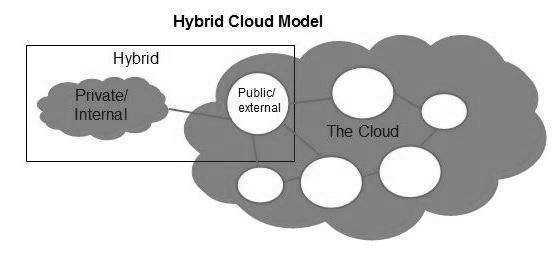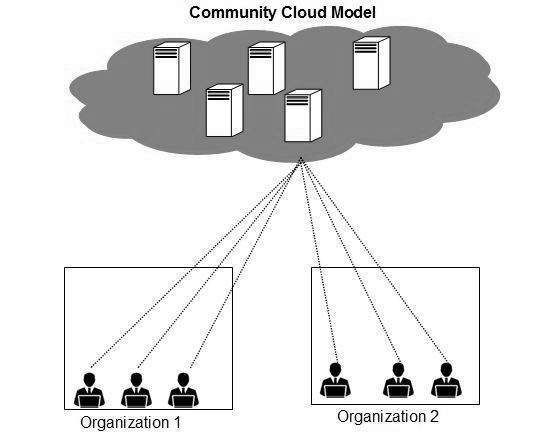There are four cloud deployment models: public, private, community, and hybrid. Each deployment model is defined according to where the infrastructure for the environment is located.
Public Cloud Model
Public Cloud allows systems and services to be easily accessible to general public. The IT giants such as Google, Amazon and Microsoft offer cloud services via Internet. The Public Cloud Model is shown in the diagram below.

Benefits
There are many benefits of deploying cloud as public cloud model. The following shows some of those benefits:
- Cost Effective : Since public cloud shares same resources with large number of customers it turns out inexpensive.
- Reliability : The public cloud employs large number of resources from different locations. If any of the resources fails, public cloud can employ another one.
- Flexibility : The public cloud can smoothly integrate with private cloud, which gives customers a flexible approach.
- Location Independence : Public cloud services are delivered through Internet, ensuring location independence.
- Utility Style Costing : Public cloud is also based on pay-per-use model and resources are accessible whenever customer needs them.
- High Scalability : Cloud resources are made available on demand from a pool of resources, i.e., they can be scaled up or down according the requirement.
Disadvantages
- Low Security : In public cloud model, data is hosted off-site and resources are shared publicly, therefore does not ensure higher level of security.
- Less Customizable : It is comparatively less customizable than private cloud.
Private Cloud Model
Private Cloud allows systems and services to be accessible within an organization. The Private Cloud is operated only within a single organization. However, it may be managed internally by the organization itself or by third-party.

Benefits
There are many benefits of deploying cloud as public cloud model. The following are the benefits of Private Cloud Model:
- High Security and Privacy : Private cloud operations are not available to general public and resources are shared from distinct pool of resources. Therefore, it ensures high security and privacy.
- More Control : The private cloud has more control on its resources and hardware than public cloud because it is accessed only within an organization.
- Cost and Energy Efficiency : The private cloud resources are not as cost effective as resources in public clouds but they offer more efficiency than public cloud resources.
Disadvantages
- Restricted Area of Operation : The private cloud is only accessible locally and is very difficult to deploy globally.
- High Priced : Purchasing new hardware in order to fulfill the demand is a costly transaction.
- Limited Scalability : The private cloud can be scaled only within capacity of internal hosted resources.
- Additional Skills : In order to maintain cloud deployment, organization requires skilled expertise.
Hybrid Cloud Model
Hybrid Cloud is a mixture of public and private cloud. Non-critical activities are performed using public cloud while the critical activities are performed using private cloud. The Hybrid Cloud Model is shown in the diagram below.

Benefits
There are many benefits of deploying cloud as hybrid cloud model. The following shows some of those benefits:
- Scalability : It offers features of both, the public cloud scalability and the private cloud scalability.
- Flexibility : It offers secure resources and scalable public resources.
- Security : The private cloud in hybrid cloud ensures higher degree of security.
- Cost Efficiency : Public clouds are more cost effective than private ones. Therefore, hybrid clouds can be cost saving.
Disadvantages
- Networking Issues : Networking becomes complex due to presence of private and public cloud.
- Security Compliance : It is necessary to ensure that cloud services are compliant with security policies of the organization.
- Infrastructure Dependency : The hybrid cloud model is dependent on internal IT infrastructure, therefore it is necessary to ensure redundancy across data centers.
Community Cloud Model
Community Cloud allows system and services to be accessible by group of organizations. It shares the infrastructure between several organizations from a specific community. It may be managed internally by organizations or by the third-party.

Benefits
- Low Cost : Community cloud offers same advantages as that of private cloud at low cost.
- Sharing Among Organizations : Community cloud provides an infrastructure to share cloud resources and capabilities among several organizations.
- Security : The community cloud is comparatively more secure than the public cloud but less secured than the private cloud.
Disadvantages
- Since all data is located at one place, one must be careful in storing data in community cloud because it might be accessible to others.
- It is also challenging to allocate responsibilities of governance, security and cost among organizations.





